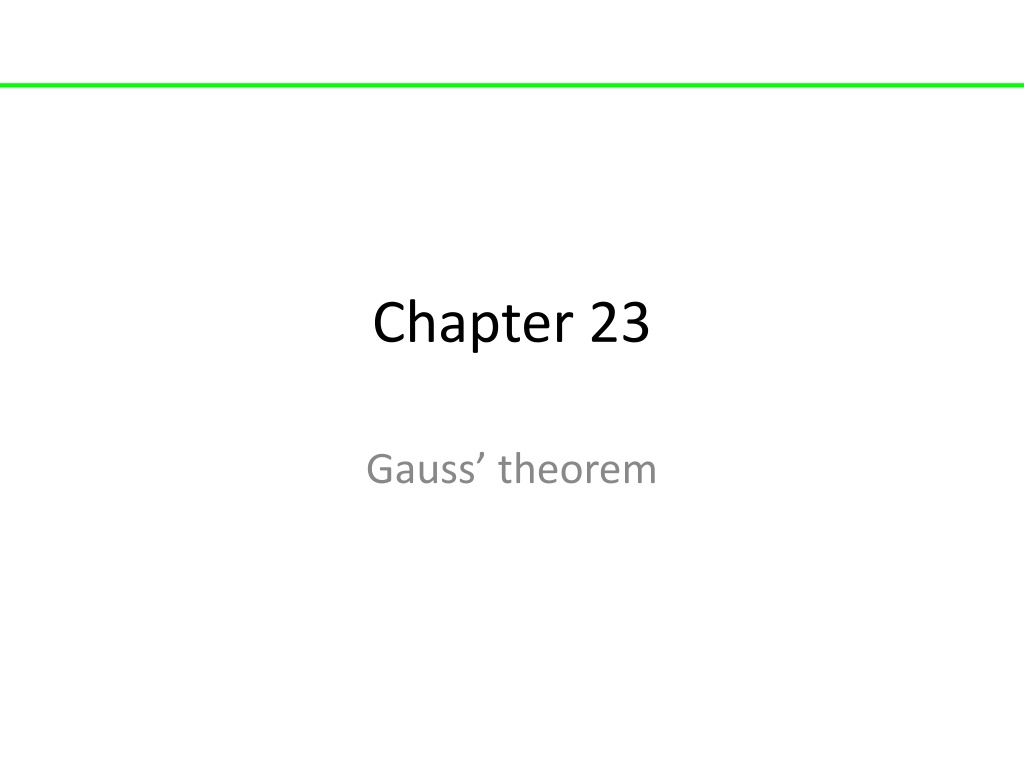
Understanding Gauss Theorem in Electric Flux
Learn about Gauss's theorem and its application in calculating electric flux through surfaces. Explore examples and concepts related to electric field lines and Gaussian surfaces. Find solutions to problems involving electric flux and field orientation.
Download Presentation

Please find below an Image/Link to download the presentation.
The content on the website is provided AS IS for your information and personal use only. It may not be sold, licensed, or shared on other websites without obtaining consent from the author. Download presentation by click this link. If you encounter any issues during the download, it is possible that the publisher has removed the file from their server.
E N D
Presentation Transcript
Chapter 23 Gauss theorem
= ( ) V vt A A A = / V t vA A = / cos( ) V t vA t 0 The flux depends on the orientation (direction) of the surface. The direction of the surface is taken normal to the surface and pointing away from the body. V= cos( ) vA t = 00, flux is +ve =1800, flux is -ve V . = = ( ) flux v A A t . A A = v A A Total Flux . = v A If varies point to point in the surface we have to divide the surface into small elements dA. If A is very small . = v d A Flux in the close surface A . = v d A
+q Many filed lines pass through area A Few filed lines pass through area A Number of field lines . N = = E d A A
Electric Flux . = E d A Average electric flux . N = E A E The electric flux is the scalar product of Electric field and the area through which field lines passes. EA = Unit ) ( = cos( Nm ) 2 / C T061: Q#6. When a piece of paper is held with its face perpendicular to a uniform electric field the flux through it is 25.0 N m2/C. When the paper is turned 25.0o with respect to the field the flux through it is: (Ans: 22.7 N m2/C )
T061: Q#6. When a piece of paper is held with its face perpendicular to a uniform electric field the flux through it is 25.0 N m2/C. When the paper is turned 25.0o with respect to the field the flux through it is: (Ans: 22.7 N m2/C )
. = E E d A 2 1 3 dA = + + . . . E d A E d A E d A 1 2 3 Such an imaginary surface is called Gaussian surface = + + cos cos cos EdA EdA EdA 1 2 3 =1800 =900 0 =00 = + + = 0 EA EA Net electric flux in a chargeless close surface is zero For a chargeless close surface: flux in = flux out The electric flux through a Gaussian surface is proportional to the net number of electric field lines passing through the surface
T81-Q7. If the constant electric field in Fig 2 has a magnitude E = 25 N/C, calculate the electric flux through the curved surface of the hemisphere (half a sphere of radius R = 5.0 cm). (Knowing that the electric field is perpendicular to the flat surface and that the hemisphere encloses no electric charges.) (Ans: 0.20 N m2/C) T103-Q9. The flux (in N.m2/C) of the electric field E=(24 N/C) i + (30 N/C) j + (16 N/C) k through a 1.5 m2 portion of the yz plane is: A) 36 T111-Q7. A uniform electric field is given by: E = 2i +4j -5k (N/C). A square plate, of side 10 cm, lies in the xy plane. What is the value of the electric flux through the plate? A) 0.05 N.m2 /C T71-Q5. When a piece of paper is held with its face perpendicular to a uniform electric field the flux through it is 30.0 N m /C. When the paper is turned at certain angle with respect to the field the flux through it is 24.6 N m2/C. What is the angle? (Ans: 35o)
T111-Q7. A uniform electric field is given by: E = 2i +4j -5k (N/C). A square plate, of side 10 cm, lies in the xy plane. What is the value of the electric flux through the plate? A) 0.05 N.m2 /C
T81-Q7. If the constant electric field in Fig 2 has a magnitude E = 25 N/C, calculate the electric flux through the curved surface of the hemisphere (half a sphere of radius R = 5.0 cm). (Knowing that the electric field is perpendicular to the flat surface and that the hemisphere encloses no electric charges.) (Ans: 0.20 N m2/C)
T101Q5. A charge of 0.80 109 C is placed at the center of a cube that measures 4.0 m along each edge. What is the electric flux through any two faces of the cube? A) 30 N m2/C T83-Q5. The flux of an electric field E = (24N/C) i + (30N/C) j + (16N/C) k through a 2.0 m2 portion of the yz plane is: A) 48 N.m2 /C
. + 2 = E EdA d A +q 1 2 3 EdA = + . . . E d A E d A E d A 1 2 3 = + + cos cos cos EdA dA 1 3 = 00 in many spots. Hence there will be net flux. Such an imaginary surface is called Gaussian surface 0 Net flux in a closed charged surface is not zero but it is given by q Enclosed charge = enc Permeability of vacuum 0 1 1 = = = 12 2 2 . 8 85 10 / C Nm 0 . 8 . 9 4 4 99 10 k This is Gauss law E q = . enc d A 0
Gausses Theorem For any imaginary surface enclosing charge q E q = = . enc d A 0 q Purpose of Gauss theorem is to find the electric field due to different shaped charge objects. Imaginary surface (Gaussian Surface)
1. What is the flux through S1 ? qenc= q = 1 0 0 2. What is the flux through S2 ? qenc = = q 1 0 0 Charge is negative, electric field is negative 3. What is the flux through S3 ? 3= 0 No charge enclosed 4. What is the flux through S4 ? 4= 0 Net charge enclosed is zero
What is the net electric flux through the gaussian surface S ? + + q qenc q q q = = = 1 2 3 enc 0 0 0 Ans: -670 Nm2/C
q = enc 0 Ans: Same for all surfaces T62-Q6. A point charge of 12 C is placed at the center of a spherical shell of radius 12 cm. Find the ratio of the total electric flux through the entire surface of the shell to that of a concentric spherical surface of radius 6.0 cm. (Ans:1)
72-Q7.For the electric field: E = (10 i + 20y j) N/C, what is the electric flux through a 2.0 m2 portion of the xy-plane? (Ans: Zero.) T81-Q6. Fig. 1 shows a Gaussian surface in the shape of a cube with edge 2.0 m. This cube lies in a region where the electric field vector is given by: ( 4.0 8.0 N/C E i j = + ) Find the net charge contained in the cube. (Ans: 0 ) T102-Q5. Figure 1 shows a Gaussian cube in region where the electric field is along the y-axis. E = -30.0 j N/C on the top face and E = +20.0 j N/C on the bottom face of the cube. Determine the net charge contained within the cube. Fig# 1 A) 1.77 10-9 C T92-Q9. A non-uniform electric field given by E = 3.0 xi + 4.0 j pierces the Gaussian surface that is in the form of a cylinder of radius 1.0 m (see Figure 2). What is the net charge inside the cylinder? A) 6
T102-Q5. Figure 1 shows a Gaussian cube in region where the electric field is along the y-axis. E = -30.0 j N/C on the top face and E = +20.0 j N/C on the bottom face of the cube. Determine the net charge contained within the cube. Fig# 1 A) 1.77 10-9 C
T92-Q9. A non-uniform electric field given by E = 3.0 xi + 4.0 j pierces the Gaussian surface that is in the form of a cylinder of radius 1.0 m (see Figure 2). What is the net charge inside the cylinder? A) 6
1 q = E 2 4 r 0 +1C r q E = k 2 r +q
Gauss law q = enc 0 q = . E d A dA q 0 r = 0 = cos( ) EdA But +q 0 q = E dA 0 = = 4 r q 2 dA A = 2 4 E r = 0 q q This is Coulomb s law = E k 2 2 4 r r 0
- - - - E = 0 inside the conductor - - - - - When you put an excess charge in a conductor it will always float outside the surface. No extra charge will remain inside the metal. - - - - - - - - - - - - - - - - - The net electric field (flux) must be zero inside a conductor. If there is net electric field inside the conductor it will generates net force (qE) on the charge that force will move the charge giving rise to a be a net current. - - - - - Gaussian Surface Hence, if we draw a Gaussian surface just inside the metallic surface the electric flux through Gaussian surface must be zero. The extra charge in a conductor always remain uniformly distributed in the surface outside the Gaussian surface but not inside the body
E=0 E =0 means q = 0 No net charge inside the conductor No net flux through the Gaussian surface: No net charge inside the cavity T011: Q#3: An isolated conductor of arbitrary shape has a net charge of -15x10-6 C. Inside the conductor is a cavity within which is a point charge q=- -5x10-6 C. What is the charge on the cavity-wall, qin, and what is the charge on the outer surface of the conductor, qout? Ans: qin = 5.0x10x-6 C; qout = - 20x10-6C
Metal Sheet Opposite face All charge in the outer face +Q +Q +2Q This face When we roll out the sheet in the form of cylinder (cavity, hollow inside) the charge will only reside the outer surface not in the inner surface Will have charge equally distributed both faces
+ + + + + + + + + + L q = Liner charge density ( ) L + + + + + + + + + + + + + + + + + + + + + + + + + + + + + q = Surface charge density ( ) A A + + + + + + + + + + + + + + + + + + V q = Volume charge density ( ) V + + + + + + + + + +
Spherical Symmetry A Spherical Symmetry will converse to a Point
Finding electric field on the surface of the conducting sphere Finding electric field inside the metallic sphere + + + 1. Draw the Gaussian surface of spherical symmetry with radius r. 1. Draw the Gaussian surface of spherical symmetry with radius r = R. + + +q + + P P + r r + + + R 2. Find total charge enclosed inside the Gaussian surface. In this case Total charge q is enclosed inside. + 2. Find total charge enclosed inside the Gaussian surface. In this case charge enclosed is zero. R qenc=0 E = 0 + + + + q + + = , r R q q = + , 0 r R q + enc + enc 3. Use Gausses Law to find electric field q q EA = enc = 2 4 E R 3. Use Gausses Law to find electric field 0 0 q kq R EA = enc = 0 E = E 0 2 Same as the Point charge at the center of the Gaussian sphere
To find electric field outside E, we need to draw gaussion surface of radius ro > R. It encloses the all chagre +q P ro = , r R q q o enc R According to Gaussian theorem q EA = enc 0 q q = E = 2 4 E r 2 4 r o 0 o 0 kq r = E 2 o Same as the Point charge at the center of the Gaussian sphere
Conducting Shell Conducting Shell + + + - + + - - - + + - - - + + - - +q + - + +q - - + - + - - + - + - - + - + + + - + +q charge at the center of the cell induces q charge inside and +q charge outside surface. If the +q charge inside the cell is offset it will change the distribution of q charges but the +q charges on the surface will remain uniformly distributed Charges in a surface of a conductor are always uniformly distributed
E - in the surface or the outside the conductor E - inside the hollow region E - inside the conductor + + P + - + + - - P + + - - + - - - + + + - P r + r - - + + - rin + - - - +q +q +q + + - - + - - - + + - + - - - - + + - + + - - - + + - + + + Gaussian Surface Gaussian Surface Gaussian Surface = + = , 0 R r R q q q in out enc = = + + = , , r R q q out r R q q q q q in in enc out enc q EA = enc Point charge Point charge 0 kq r = 0 E kq R = E kq = E = or E 2 2 2 out r in out Inside metal
qenc Insulating= Non conducting = Volume charge density: V q Q Q = total charge 3 = = in r in= in q Q 3 3 R 4 r 4 3 R 3 in 3 From gausses Theorem q = in E A in o 0 q P 2 = 4 in E r in in 0 kQ R Qr = = E r in R E in in in 3 3 4 0 If Point P is in the surface, (r = R ) it behaves like a point charge at the center of the sphere: Same as in the case of metal kq E R = 2 If Point P is outside the surface, (r > R ) it behaves like a point charge at the center of the sphere: Same as in the case of metal kq = E 2 out r
Insulating shell = qenc V 3 = 3 ( ) q r R 4 4 in 3 3 P If Point P is outside or in the surface: (r = R or r > R) r Rin 3 3 = ( ) q R R 4 4 out in 3 3 Rout q EA = enc 0 q = 2 4 enc E r 0
Conducting Sphere Insulating Sphere For r < R, inside For r < R, inside kQ R = E r E = 0 in in 3 For r = R, in the surface For r = R, in the surface kQ R kQ R = E = E 2 2 For r > R, outside For r > R, outside kQ kQ = E = E 2 out r 2 out r
Summary of applying Gausses law 1. Find what symmetry is it? 2. Draw Gaussian surface of the symmetry starting from the point at which electric field has to be found. 3. Find the charge enclose inside the Gaussian surface. If the symmetry is spherical, the enclosed charge will behave like a point charge at the center of the sphere. If the symmetry is cylindrical, the enclosed charge will behave like the line charge.
Conducting Spherical Shell T081 Q5. A spherical conducting shell has charge Q. A particle with charge q is placed at the center of the spherical shell. The charge on the inner surface of the shell and the charge on the outer surface of the shell, respectively, are: (Ans: q, (Q + q)) T52-Q#15. A conducting spherical shell with a net charge qo has an outer radius R. A point charge qo is placed at a distance R/3 from the center of the shell. What is the surface charge density on the outer surface of the shell? (Ans: 2qo / 4 R2) T82-Q5.Consider a conducting neutral spherical shell having an inner radius of 3.70 cm and an outer radius of 4.50 cm. A positive point charge q is placed at the center of the shell. The magnitude of the electric field a distance 5.00 cm from the center of the shell is 2500 N/C. Calculate the magnitude of the charge density on the outer surface of the shell. A) 2.73 10 8 C/m2 T91-Q7. A point charge q = + 4.00 C is placed at the center of a conducting spherical shell. The net electric flux outside the shell is 1.00 106 N.m2/C. What is the net charge of the shell? A) 12.9 C T103-Q8. Consider a spherical shell of radius R and charge Q distributed uniformly on its surface. Find the radial distance where the electric field due to the shell is half its maximum value. A) 2R
Conducting Spherical Shell T081 Q5. A spherical conducting shell has charge Q. A particle with charge q is placed at the center of the spherical shell. The charge on the inner surface of the shell and the charge on the outer surface of the shell, respectively, are: (Ans: q, (Q + q)) T103-Q8. Consider a spherical shell of radius R and charge Q distributed uniformly on its surface. Find the radial distance where the electric field due to the shell is half its maximum value. A) 2R
T103-Q10. The electric field just outside the surface of a hollow conducting sphere of radius 20 cm is 500 N/C and directed radially outward. An unknown charge Q is placed at the center of the sphere and it is noted that the electric field at the same location is still directed radially outward, but has decreased to 100 N/C. What is the magnitude of the charge Q? A) 1.8 nC T103-Q11. A point charge of 10.0 nC is placed at the center of a hollow spherical conductor of inner radius 5.00 cm and outer radius 6.00 cm. The spherical conductor has a net charge of 5.00 nC. Determine the surface charge density on the inner surface of the conductor. A) 318 nC/m2 T111-Q6. The electric field at point P just outside the outer surface of a hollow spherical conductor of inner radius 10 cm and outer radius 20 cm has magnitude 450 N/C and is directed outward. When an unknown point charge Q is placed at the center of the sphere, the electric field at point P is still pointing outward but is now 180 N/C. What is the value of charge Q? A) 1.2 nC 92-Q11. Figure 3 shows a cross section of a neutral spherical metal shell of inner radius R. A point charge q = 5.0 C is located at a distance 4R/5 from the center of the shell. Points 1, 2, 3, and 4 are all the same distance from the center of the spherical shell. At which point is the magnitude of the electric field the largest? A) The electric field is the same at points 1, 2, 3 and 4
T103-Q10. The electric field just outside the surface of a hollow conducting sphere of radius 20 cm is 500 N/C and directed radially outward. An unknown charge Q is placed at the center of the sphere and it is noted that the electric field at the same location is still directed radially outward, but has decreased to 100 N/C. What is the magnitude of the charge Q? A) 1.8 nC
92-Q11. Figure 3 shows a cross section of a neutral spherical metal shell of inner radius R. A point charge q = 5.0 C is located at a distance 4R/5 from the center of the shell. Points 1, 2, 3, and 4 are all the same distance from the center of the spherical shell. At which point is the magnitude of the electric field the largest? A) The electric field is the same at points 1, 2, 3 and 4
T102-Q8. Which of the following statements is NOT TRUE? A) If a charged particle is placed inside a spherical shell of uniform charge density, there is a non-zero electrostatic force on the particle from the shell. B) The electric field is zero everywhere inside a conductor in electrostatic equilibrium. C) Any excess charge placed on an isolated conductor in electrostatic equilibrium resides on its surface. D) The electric field just outside a charged conductor in electrostatic equilibrium is perpendicular to its surface. E) The net electric flux through any closed surface is proportional to the net charge inside the surface. T111-Q9. A solid isolated charged conductor is in electrostatic equilibrium. Choose the TRUE statement: A) Any excess charge is confined to the surface of the conductor. B) Excess charge is distributed throughout the volume C) There of the conductor. is an electric field inside D) There is the conductor. no electric field at the surface E) Electric flux through a Gaussian surface of the conductor. inside the conductor is non-zero. T101-Q6. A positive charge Q = +5.0 10 9 C is placed on a conducting spherical shell with inner radius R1 = 5.0 mm and outer radius R2 = 6.0 mm. A point charge q = +1.0 10 9 C is placed at the center of the shell. The surface charge density on the outer surface of the conducting shell is: A) +1.3 10 5 C/m2
Insulating (Dielectric, non-conducting) sphere, shell, cylinder T52-Q#8. A large insulating solid sphere has a charge density of 5 nC/m3. Calculate the electric field inside the sphere at a distance of 10 cm from its center. (Ans: 18.8 N/C ) T032: Q#14: A total charge of 5.00x10-6 C is uniformly distributed inside an irregularly shaped insulator. The volume of the insulator is 3.0 m3. Now, imagine a cube of volume 0.50 m3 inside the insulator. What is the total electric flux through the surfaces of the cube? (Ans: 9.4x104 Nm2/C.) T61-Q#7. Charge Q is distributed uniformly throughout a spherical insulating shell. The net electric flux in N m2/C through the inner surface of the shell is: (Ans: 0 ) T72-Q8. A solid nonconducting sphere, of radius 4.0 m, has a uniform charge density. What is the ratio of the magnitude of the electric field at a distance 2.0 m from the center to the magnitude of the electric field at the surface of the sphere? (Ans: 0.5) T71-Q8. An insulating spherical shell of radius 15 cm has a total charge of 10 C uniformly distributed on its surface. Calculate the electric field intensity at a distance of 14 cm from the center of the shell. (Ans: 0)
T102-Q7. Figure 3 shows the magnitude of the electric field due to a sphere with a positive charge distributed uniformly throughout its volume. What is the value of the charge on the sphere? A) 2 C T101-Q9. A non-conducting sphere of radius R = 7.0 cm carries a charge Q = 5.0 10 3 C distributed uniformly throughout its volume. At what distance within the sphere, measured from the center of the sphere does the electric field reach a value equal to half its maximum value? A) 3.5 cm T91-Q5. Positive charge q is distributed uniformly throughout an insulating sphere of radius R, centered at the origin. A particle with a positive charge q is placed at x = 2R on the x axis. The magnitude of the electric field at x = R/2 on the x axis is: A) q/72 oR2 T83-Q7. A non-conducting sphere of radius R = 10 cm carries a charge density = 10-9 C/m3 distributed uniformly throughout its volume. At what distance within the sphere, measured from the center of the sphere, the magnitude of the electric field is E = 1.32 N/m? A) 3.50 cm
T102-Q7. Figure 3 shows the magnitude of the electric field due to a sphere with a positive charge distributed uniformly throughout its volume. What is the value of the charge on the sphere? A) 2 C
Cylindrical Symmetry A cylindrical Symmetry will converse to a line
q = Infinitely large Charged Rod L = (i ) q L + + + + + + + + + + + + + q 1 = . E d A 0 q + + = . . . E d A E d A E d A 1 2 3 0 = q + + cos cos cos EdA EdA EdA 2 P r 1 2 3 0 = 900 = 00 = 900 q + + = 0 0 EA 0 L 3 = 2 E rL k 2 0 = = E Gaussian surface 2 r r 0
Insulating Cylinder Conducting Cylinder = qenc V Charge enclosed inside the Gaussian surface R + + + + + + + + + + + + + + + + + + + + + + + + + + = 2 qenc r L For r < R qenc = 2 r P = 0 E L r P r = 2 r = E 2 r 0 If the point P is in the surface or outside the surface: (r > R or r = R) For, (r > R or r = R) qenc = 2 RL = 2 qenc R L = 2 R = 2 R 2 k = = E 2 k 2 r r = = E 0 2 r r 0
Charged Conducting Rod/cylindrical symmetry T081 -Q8. A charge is distributed uniformly along a long straight wire. If the electric field 4.0 cm from the wire is 40 N/C, then the electric field 8.0 cm from the wire is: (Ans: 20 N/C) T061: Q#8. A long wire, of linear charge density l , runs along the cylindrical axis, of a cylindrical conducting shell, which carries a net linear charge density of c. The charge per unit length on the inner and outer surfaces of the shell, respectively are: [Note: linear charge density charge per unit length] (Ans: land c + l ) T052: Q#20.Consider a long wire of linear charge density . Now imagine a closed cylindrical Gaussian surface of radius r and length L with the wire as the axis. What is the electric flux through the cylinder surface? (Ans: L/ o) T071: Q6. An infinitely long uniformly charged rod is coaxial with an infinitely long uniformly charged cylindrical shell of radius 5.0 cm. The linear density of the rod is + 15 10-9 C/m and that of the cylindrical shell is 20 10-9 C/m. What is the magnitude of the electric field at a distance of 10 cm from the axis? (Ans: 900 N/C)
T072: Q6. The Fig. 2 shows short sections of two very long parallel wires carrying uniform linear charge densities + 6.0 C/m and 2.0 C/m. Find the magnitude and direction of the net electric field at point P. T042: Q#6 A very long uniform line of charge having a linear charge density of 6.8 micro- C/m lies along x-axis. A second line of charge has a linear charge density of -3.40 micro- C/m and is parallel to x-axis at y = 0.5 m. What is the net electric field at point where y= 0.25 m on y-axis? (Ans: 7.3x105 N/C along +y-axis.) T91-Q6.Figure 2 shows the cross sections of four very long rods that extend into and out of the page. The value below each rod is the uniform linear charge density in units of C/m, and the distance d = 1.0 cm. What is the net electric field at point P? A) 7.2 106 i (N/C)
T072: Q6. The Fig. 2 shows short sections of two very long parallel wires carrying uniform linear charge densities + 6.0 C/m and 2.0 C/m. Find the magnitude and direction of the net electric field at point P.














